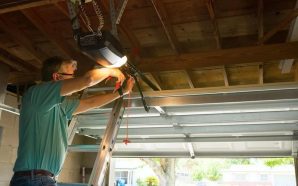It has good optimization qualities in terms of space because it does not overflow either inside or outside and therefore the perfect door model if your house is on the edge of the road.
It is not necessarily the first element that we focus on during renovations in his home, and yet the choice of your garage door deserves special attention. After all, the garage is often home to one of your most expensive items in terms of service and price, your vehicle. It is a healthy storage place that also provides access to your home. So how do you choose your garage door to ensure safety, strength, and aesthetics? Follow the guide.
What Type of Garage Door to Choose?
In addition to the aesthetic aspect, different criteria come into play in the choice of a garage door: the layout of the garage and the presence of annoying elements such as pipes, beams, or storage, the dimensions of the room, the uses made of it (living room or storage room) as well as the space available outdoors as well as indoors.
The Tilting Garage Door
It is arguably the most classic and economical model of garage doors. The tilting swing garage door is made up of a single panel which, when opening, which can be done manually or automatically thanks to the integration of a motor, is positioned under the ceiling. It may be overflowing, that is to say, it may protrude from the garage in the open position; or non-overhanging, completely positioned under the ceiling. The swing garage door is a good choice in terms of durability and budget but still has the downside that it requires sufficient maneuvering volume for comfortable use.
The Sectional Garage Door
Composed of slats or hinged panels, the sectional garage door is a particularly popular option because of its aesthetics. Another advantage and not the least, this type of garage door is ideal for optimizing the available space. Concretely, the sectional garage door slides on side rails suspended from the ceiling in order to fit under the ceiling; or on a rail placed on the ground in order to position itself against a wall in the garage. The sectional garage door with lateral sliding also offers the possibility of using one of the panels as a wicket door.
Also, sectional garage doors are known to benefit from very good thermal insulation and waterproofing, due to the manufacture of the steel panels filled with polyurethane foam as well as the presence of joints between the panels.
However, this type of door requires its equivalent in size where the door is placed when it is opened; and can thus lead to having to do without one of its walls for the side option. Note: this type of garage door is more expensive to purchase. Strong material is also essential to ensure the durability of sectional garage doors.
The Swing Garage Door
This type of garage door is made up of two panels which, like a gate, open on either side. The two panels can therefore open independently of one another. The disadvantage is the need to have sufficient space outside the garage so that the open doors do not overflow onto the sidewalk or the road, nor obstruct the passage.
The Roll-Up or Upset Garage Door
This type of garage door can be likened to a roller shutter which is housed in a box fixed to the ceiling or outside, as a roller shutter, thus saving the space required for the door and its opening. It is the zero overflow solution suitable for small spaces and low ceiling heights, which can be opened automatically thanks to the motor. Before installing a garage door, it is therefore important to know the measurements, and the space available in and outside the room, in order to choose the model of door most suited to your project.
What Material to Choose For Your Garage Door?
The choice of material for your garage door depends on aesthetic criteria, thermal performance, strength, and price:
Steel Garage Door
Steel doors have the advantage of being resistant to impact and corrosion, when the material has been treated, galvanized, and protected with coats of paint. The thinness of the material, however, gives it less thermal and sound insulation, compared to other materials such as wood. However, when they are composed of a double wall separated by thermal insulation, steel garage doors guarantee excellent thermal insulation.
Aluminum Garage Door
Aluminum offers strength, durability, and lightness to garage doors. This material is therefore more suitable for overhead-type doors and solutions requiring the door to be motorized.
PVC Garage Door
Also light, PVC doors are also particularly economical. They also offer effective thermal insulation, superior to aluminum and steel. However, due to its lightness, PVC is not the best option to protect against the risk of a break-in.
Wooden Garage Door
Particularly aesthetic, wooden doors offer very good thermal insulation. Frequent maintenance especially against humidity is nevertheless to be expected so that the material lasts as long as possible. Because wooden garage doors are much heavier than other materials, they are more suitable for side openings, which do not require suspension. Using a high-pressure or dry cleaner, the maintenance of the garage door will also depend on the wood chosen.
The Different Garage Door Motorization Systems
Because it is expensive, the motorization of the garage door can be considered optional. However, it is a key element in the comfort of use of your garage door, ideal for quickly parking your vehicle, as well as opening and closing remotely.









